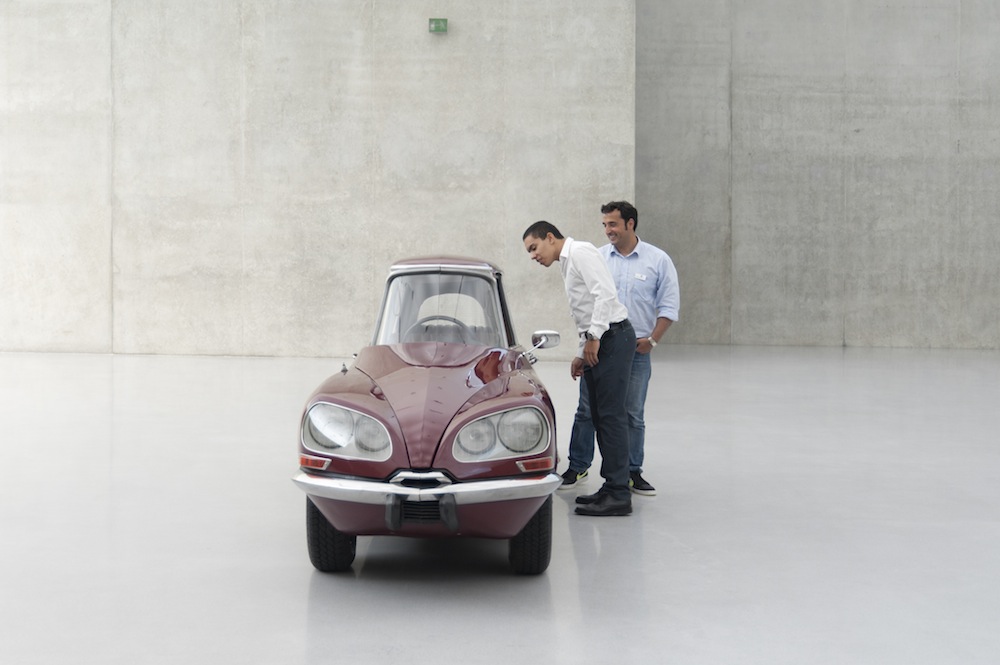Gabriel Orozco’s diptych My Hands Are My Heart (1991) is one of my favorite works in clay, indeed one of my favorite photographic works as well. Certainly it is number one on my “when I win the lottery list.” I feel less excited by the piece once it is fired. It stopped having a heartbeat at that moment. And I have always had some problems with his table arrays of terracotta works. It seems that ever since 1991, Orozco has been trying to repeat the magic of his early gesture, squeezing the clay between his palms. But with this exhibition, Gabriel Orozco Natural Motion at Kunsthuas Bregenz (July 13-October 6, 2013), something has changed with these works and I think it might be me.
Born in 1962 in Xalapa in the Mexican state of Veracruz and living today in New York, Paris, and Mexico City, Gabriel Orozco is one of the best-known international artists of his generation. Following a major retrospective from 2009 to 2011, which was on view at the New York Museum of Modern Art, the Kunstmuseum Basel, the Centre Pompidou in Paris, and the Tate Modern in London, the exhibition in Brenenz, for the most part, showed new works that have been conceived specially for the exhibition.
The museum explains Orozco as “that rare artist who can switch between classical, quasi-autonomous paintings or sculptures and transient, seemingly improvised installations, interventions, objects, and photographs. Enormously versatile in approach, he sometimes draws on atmospherically charged, found, or occasionally casual situations and objects, as well as the exact opposite: the production of precise and perfectly crafted objects. Hence, his works take up a position between analytic conceptual art and formally as well as sensually balanced artifacts. Rational engagement and the physical experience of the immediate emotional encounter with his works enter into dialog in Orozco’s oeuvre.”
The most fascinating aspect of Orozco is his unpredictability. He swings between his ephemeral, barely touched ceramic works and the high-production achievement of La DS Cornaline, 2013 (where he takes a Citroen, cuts out the center, bilateral section and then seamlessly reassembles the car into a sleek single-seater. I must admit that I am really unable to be objective about his vehicle, it is one of the “fetish” cars in my life. From that, he goes to a whale skeleton and rock sculpture with an Aztec/Mayan bent.
His large ceramic installation, Untitled (116 Terracottas), 2011/2012 is another matter. Orozco makes many of these and I have seen several. They have always left me rather unmoved. As mentioned before, it’s as though he was revisiting the scene of a past triumph but without the sense of the moment. This is an aspect that ceramists rightly find inept: ceramic emperors with no clothes.
So, step one is to dismiss them as ceramic art. In a strange way, I felt myself addressing them as photographs, records of a performance, one physical gesture at a time entered into history by the kiln. Above all, I realized their meditational demands require more than a quick visit; do not walk in, glance around and walk out, one must give the works the time they need to communicate.
That said, I found it strange that in a 24-page press package put out by the museum there is not one mention of Untitled (116 Terracottas), the largest work in the exhibition in any shape or form, except for its photo caption. Ceramists are often charged with being paranoid when dealing with the fine arts (and they are) but the gag does not mean that someone is not trying to get you, or even worse, ignore your medium. The inability of the fine arts to articulate ceramic-based work is still astounding.
Garth Clark is Chief Editor of CFile.
Above image: Gabriel Orozco, La DS Cornaline, 2013. Mixed media, 489 x 122 x 147 cm. Courtesy of the artist and Marian Goodman Gallery, New York/Paris.

Gabriel Orozco, La DS Cornaline, 2013. Mixed media. 489 x 122 x 147 cm.






Gabriel Orozco. Untitled (116 Terracottas), 2011/2012. Terracotta. Size varies.

Gabriel Orozco, Dark Wave, 2006. Calcium carbonate and resin with graphite. 304 x 392 x 1375 cm. Installed at Sammlung Essl, Klosterneuburg.

Gabriel Orozco, Turtle. Granite-diorite. 25 x 23 x 23 cm installed.

Gabriel Orozco, La DS Cornaline, 2013. Mixed media. 489 x 122 x 147 cm. All images courtesy of the artist and Marian Goodman Gallery, New York/Paris.
Learn more about Gabriel Orozco at Marian Goodman Gallery


Add your valued opinion to this post.